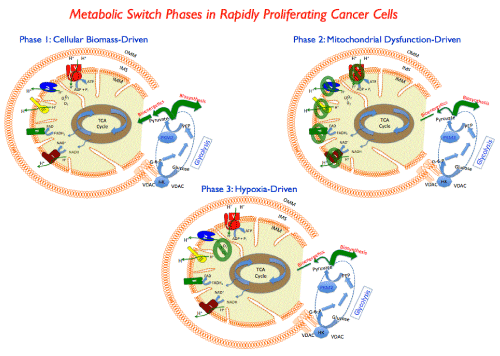
 |
| Figure 1: Three distinct phases of metabolic switch in cancer cells: Phase 1 is characterized by driving the glycolytic precursors to aid in an apparent increase in biosynthetic route in response to the need for an increased biomass for the rapidly proliferating transformed cells. Mitochondrial TCA cycle and the electron transport chain, signified by the respiratory complexes I through V, are expected to function without significant loss in function. Phase 2 stems from one or more mitochondrial electron transport complex dysfunction and/or other enzymatic defects – thereby exacerbating glycolytic output. Phase 3 is characterized by oxygen deficit (hypoxia) and mitochondrial respiratory chain output is expected to be minimal despite a functional electron transport chain since the terminal step is deprived of oxygen to impact the bioenergetics. OMM: outer mitochondrial membrane; IMM: inner mitochondrial membrane; IMS: intermembrane space; NADH and FADH2 are the reducing equivalents that feed into the respiratory chain complexes I and II respectively; The rate limiting enzymes hexokinase 2 (HK2) and M2 isoform of pyruvate kinase (PKM2) are shown in the glycolytic pathway. The decision making step for biosynthetic diversion is at the site of PKM2 which in turn, catalyzes the conversion of phosphoenolpyruvate (PEP) to pyruvate. An increased biomass requirement is expected to minimize pyruvate production as compared to normal biosynthetic/ bioenergetic balance. |